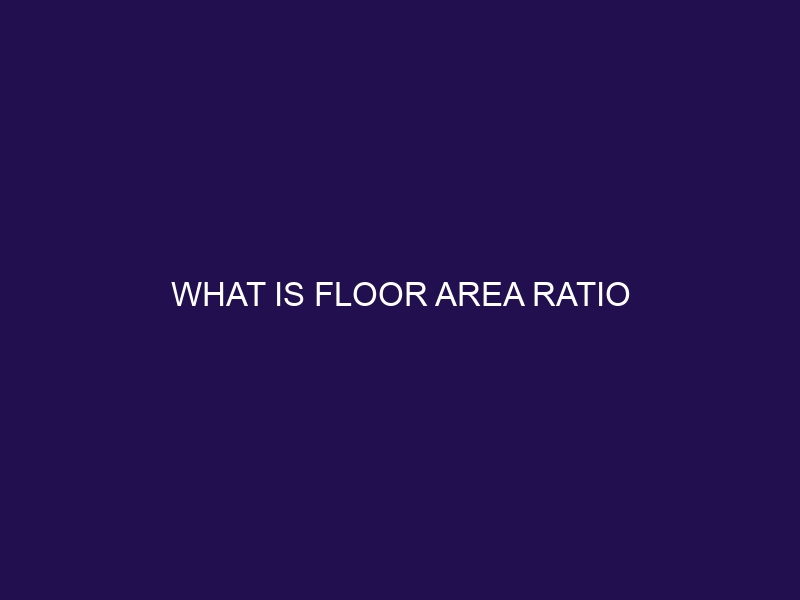What is Floor Area Ratio
Floor Area Ratio (FAR) is a critical concept in urban planning and zoning that determines the allowed density and size of buildings within a specific area. It plays a significant role in shaping the built environment of a city or town. Understanding FAR is essential for architects, developers, and policymakers involved in urban development projects.
FAR is the ratio of the total floor area of a building to the size of the land on which it is constructed. It serves as a tool to regulate building density and establish guidelines for urban growth and development. By setting limits on the amount of floor space that can be constructed on a particular piece of land, FAR helps maintain the balance between population density, infrastructure capacity, and environmental considerations.
Calculating FAR involves dividing the total floor area of a building by the gross area of the land. The resulting ratio indicates how much area can be covered or built upon compared to the available land. Higher FAR values indicate denser development, while lower ratios imply more open space and less building density.
The importance of FAR lies in its ability to shape the character and functionality of a city or neighborhood. Regulating FAR can help achieve several benefits, including efficient land use, preservation of open spaces, and the creation of vibrant, walkable communities. Factors like zoning regulations, building heights, setbacks, and public amenities influence FAR values and their impact on the urban landscape.
FAR also plays a crucial role in urban design and architecture. It influences building heights, setback requirements, and the overall aesthetic appeal of a city. Floor area ratios can impact the scale, density, and visual harmony of a neighborhood, influencing the quality of life for its residents.
However, FAR is not without challenges and controversies. Critics argue that high FAR values can lead to overcrowding, traffic congestion, and strain on infrastructure. The effects of FAR on affordability and gentrification have also been subjects of debate and concern.
Understanding Floor Area Ratio
Understanding floor area ratio (FAR) is crucial in construction and planning. Here are a few steps to help you grasp FAR effectively:
- Get familiar with the concept of FAR, which determines the maximum amount of building space permitted on a given piece of land.
- Conduct thorough research on local zoning regulations to comprehend how FAR is calculated in your specific area.
- Take into account the impact of FAR on building design and population density.
- Gain an understanding of how FAR can influence the utilization of open space and allocation of resources.
Were you aware that certain cities enable developers to transfer unused FAR from one location to another? This allows for increased building density in specific zones while preserving open spaces in others!
What is Floor Area Ratio and its Purpose?
Floor Area Ratio (FAR) is a planning tool used to regulate the intensity of development in a specific area. It is the ratio of a building’s total floor area to the size of the plot it sits on. The purpose of the Floor Area Ratio (FAR) is to control the size, density, and scale of buildings, ensuring that they are in harmony with the surrounding environment and infrastructure. By setting limits on the Floor Area Ratio (FAR), local governments can manage issues such as overcrowding, traffic congestion, and strain on public services. The Floor Area Ratio (FAR) also plays a crucial role in urban planning and zoning by guiding the design and distribution of buildings within a city or neighborhood. Suggestions include conducting a thorough analysis of the site and considering the impact of the Floor Area Ratio (FAR) on the overall community.
What is Floor Area Ratio and its Purpose?
How is Floor Area Ratio Calculated?
In order to calculate the floor area ratio, there are several key steps that need to be followed to determine the permissible floor area of a building. These steps include:
1. Measuring the area of each floor to determine the total floor area of the building.
2. Excluding specific areas such as basements, mechanical rooms, and parking garages from the calculation.
3. Dividing the total floor area by the area of the plot or lot to obtain the floor area ratio.
4. For instance, if the total floor area is 10,000 square feet and the lot size is 5,000 square feet, the floor area ratio would be 2.
The calculated floor area ratio is essential as it helps establish the maximum permissible size of a building on a given plot or lot. This ratio plays a critical role in determining building density and facilitating appropriate urban planning and zoning.
What Does Floor Area Ratio Indicate?
Floor Area Ratio (FAR) is a crucial metric used in urban planning and zoning regulations to determine the intensity of development allowed on a specific plot of land. FAR indicates the ratio of a building’s total floor area to the total land area on which it is built. A higher FAR indicates taller and more densely constructed buildings, while a lower FAR suggests more open space. This ratio helps ensure efficient land use, control building density, and maintain a balance between development and open space. By understanding what does Floor Area Ratio indicate, city planners can guide sustainable and organized urban growth while considering factors like transportation, infrastructure, and community needs.
In the city of Vancouver, Canada, the implementation of a high FAR in certain neighborhoods led to the development of numerous high-rise residential buildings. This resulted in increased population density and improved access to amenities due to the efficient use of land. Concerns were raised about the loss of neighborhood character and affordability. To address these issues, the city introduced regulations to set specific FAR limits, encouraging a mix of building types and affordable housing options within the neighborhoods. This shows how FAR can influence the livability and affordability of urban areas.
Importance of Floor Area Ratio
When it comes to understanding the importance of Floor Area Ratio, we dive into two fascinating aspects. First, we explore the benefits of regulating Floor Area Ratio, unearthing why it matters for urban planning. Then, we unravel the factors that have a significant influence on Floor Area Ratio, shedding light on the key variables that shape the built environment. Get ready to explore the intricate dynamics behind this fundamental concept in urban development!
Benefits of Regulating Floor Area Ratio
Regulating floor area ratio (FAR) provides numerous advantages in the field of urban planning and development. By imposing restrictions on the amount of floor space that can be constructed on a particular plot of land, FAR regulation encourages the creation of compact and densely populated areas. This approach greatly optimizes land usage and prevents the expansion of urban sprawl. Moreover, controlling FAR promotes the convenience of walking and accessing public transport, as it ensures that developments are concentrated in areas that have favorable transportation links and amenities. This not only enhances walkability but also reduces reliance on private vehicles, thereby supporting sustainable transportation alternatives. Additionally, regulating FAR contributes to the preservation of open spaces and green areas, thereby enhancing the overall quality of life for residents by providing recreational spaces. Furthermore, FAR regulations play a vital role in maintaining the distinct character and architectural heritage of different neighborhoods by imposing limits on building size and scale. Throughout history, cities worldwide have implemented FAR regulations to strike a balance between urban growth, environmental sustainability, and livability for residents.
Factors Influencing Floor Area Ratio
Factors influencing floor area ratio, such as zoning regulations, urban planning goals, building codes, and community preferences, play a significant role. Zoning regulations establish limits on building height, setback requirements, and density, all of which indirectly impact the floor area ratio. Urban planning goals strive to either promote a specific level of density or protect open spaces. Building codes, on the other hand, ensure safety and compliance. Community preferences also contribute to the floor area ratio as they seek to maintain the area’s character and visual appeal. Consequently, local authorities must carefully consider these various factors in order to strike a balance between promoting development and preserving the community’s overall quality of life.
Role of Floor Area Ratio in Urban Planning and Zoning
Floor Area Ratio (FAR) plays a crucial role in urban planning and zoning regulations. The role of FAR in urban planning and zoning is to determine the maximum allowable floor area in relation to the size of the lot. By controlling the density and size of buildings, FAR helps maintain a balance between population growth and infrastructure development. It guides the creation of vibrant and sustainable communities in urban planning. Additionally, FAR ensures efficient land use, preserves open spaces, and manages building heights. Zoning regulations rely on FAR to enforce development standards and maintain the overall character of a neighborhood. Planners and policymakers utilize FAR as a tool to shape and control urban growth effectively.
How Does Floor Area Ratio Affect Building Density?
Floor Area Ratio (FAR) plays a significant role in determining building density in urban areas. Here is a list of points illustrating how FAR affects building density:
- Higher FAR allows for more floor space to be constructed on a given plot of land, leading to increased building density.
- In areas with a low FAR, buildings are more spread out, resulting in lower building density.
- FAR influences the height, size, and volume of buildings within a particular zone, directly impacting the level of density.
- Regulating FAR helps balance density and open space, ensuring sustainable urban development.
- Increased building density due to higher FAR can result in more mixed-use developments and improved access to amenities.
True story: In a bustling city, the implementation of a higher FAR resulted in a rejuvenation of the downtown area. By allowing for taller buildings and increased floor space, the city witnessed a surge in the number of businesses and residents. This revitalization not only increased economic activity but also fostered a vibrant and dynamic urban environment.
How Does Floor Area Ratio Affect Building Density?
Impact of Floor Area Ratio on Urban Design
The impact of Floor Area Ratio (FAR) on urban design is significant, as it greatly influences the physical form and character of a city. The FAR determines the density, scale, and intensity of development within a specific area, leading to various effects on urban design.
One crucial way in which FAR influences urban design is through building form. A higher FAR can result in the construction of taller and more compact buildings, while a lower FAR may promote low-rise or open development.
Additionally, FAR regulations play a role in ensuring the provision of adequate public space within a development. By setting specific requirements, FAR can facilitate the inclusion of open spaces, public amenities, and green areas, enhancing the overall livability of the urban environment.
The influence of FAR extends to the streetscape as well. Through setbacks, building heights, and the relationship between buildings and the surrounding environment, FAR can shape the visual aspects of the streetscape, ultimately impacting the overall urban design.
Maintaining the visual harmony and coherence of a city is another key aspect influenced by FAR. Regulations regarding FAR can help control the massing, proportions, and overall appearance of buildings, contributing to a visually appealing cityscape.
By considering the impact of FAR on urban design, authorities can effectively guide the development process. By aligning with the vision and goals of the city, sustainable and aesthetically pleasing development can be achieved.
Relationship Between Floor Area Ratio and Building Heights
Floor Area Ratio (FAR) is a key factor in determining building heights in urban planning. The connection between FAR and building heights is generally proportional, meaning that higher FAR values allow for taller buildings. This correlation is based on the principle that higher FAR values imply greater density and development intensity. By using FAR regulations to control building heights, cities can effectively manage the vertical growth of their urban areas. For instance, regions with higher FAR values may feature towering skyscrapers, while areas with lower FAR values may have shorter buildings to maintain a balanced urban landscape.
Historically, the relationship between FAR and building heights has evolved alongside urban development. As cities grew vertically, zoning laws and regulations were implemented to regulate building heights and prevent overcrowding. These regulations considered various factors such as infrastructure capacity, aesthetic considerations, and the preservation of historical or cultural landmarks. The objective was to achieve a balance between accommodating growth and maintaining a harmonious urban environment. Today, the connection between FAR and building heights remains a crucial tool in urban planning.
Challenges and Controversies Surrounding Floor Area Ratio
The challenges and controversies surrounding Floor Area Ratio (FAR) are both fascinating and contentious. With critics questioning its effectiveness and advocates considering its impact on affordability and gentrification, this section dives into these two sub-sections. Get ready to explore the critiques of FAR and understand how it influences the complex issues of affordability and gentrification. Brace yourself for a thought-provoking journey through the intricacies of Floor Area Ratio.
Critiques of Floor Area Ratio
Critiques of Floor Area Ratio are at the forefront of concerns regarding its effectiveness and impact on urban development. Critics argue that its strict adherence to Floor Area Ratio limits can stifle creativity and hinder innovative architectural designs, leading to a lack of flexibility. Additionally, Floor Area Ratio fails to consider the unique characteristics and needs of different neighborhoods, disregarding the context and resulting in generic and monotonous urban landscapes.
Another critique is the displacement of affordable housing. Some argue that high Floor Area Ratios often lead to the demolition of existing affordable housing and the subsequent construction of luxury developments. This contributes to gentrification and the displacement of vulnerable communities.
Furthermore, critics contend that relying solely on Floor Area Ratio to regulate building density overlooks other important factors such as building height, setbacks, and open spaces. They argue that this misrepresents the true density of the area.
To address these critiques, urban planners and policymakers should consider incorporating more flexible zoning regulations. By doing so, they can promote innovative architectural designs while still maintaining appropriate density and floor area. It is also important to prioritize community engagement in decision-making processes. This ensures that the unique characteristics and needs of different neighborhoods are taken into consideration. Lastly, measures should be implemented to safeguard affordable housing in areas subject to increased development. This can help mitigate the displacement of vulnerable communities and prevent the negative effects of gentrification.
Overall, addressing the critiques of Floor Area Ratio requires a comprehensive approach that combines flexibility, community engagement, and the protection of affordable housing.
Effects of Floor Area Ratio on Affordability and Gentrification
The effects of the floor area ratio (FAR) on affordability and gentrification are significant in urban areas. When the FAR is low, it restricts the amount of space available for development, leading to higher property prices. Consequently, this can displace lower-income residents and transform neighborhoods into more upscale areas. Conversely, higher FAR values permit denser development, which can increase the housing supply and potentially offer more affordable options. Therefore, it is crucial to strike a balance between FAR regulations and affordable housing policies to mitigate the negative effects of FAR on affordability and gentrification.
In a city where FAR restrictions were eased, developers had the opportunity to erect taller buildings with more housing units. This resulted in a greater availability of affordable housing options, preventing the displacement of low-income residents. As a result, the neighborhood became more diverse, encompassing a mixture of affordable and market-rate housing, fostering a vibrant and inclusive community. This success story emphasizes the importance of considering the effects of FAR on affordability and gentrification when making urban planning decisions.
Frequently Asked Questions
What is Floor Area Ratio (FAR) and how is it calculated?
Floor Area Ratio (FAR) is a measurement used in urban planning to determine the intensity of development by calculating the ratio of a building’s total floor area to the size of the land it is built on. It is calculated by dividing the total floor area of the building by the buildable land area.
How does Floor Area Ratio (FAR) impact development and zoning regulations?
Floor Area Ratio (FAR) plays a key role in urban planning and zoning codes. Zoning codes set FAR ratios that align with desired development outcomes, with larger FARs indicating a preference for more and larger developments. FAR is used to limit land use intensity, control the scale of development, and determine regulations such as building heights, parking requirements, and residential units.
Is Floor Area Ratio (FAR) the same as density?
No, Floor Area Ratio (FAR) and density are not the same. While FAR measures the intensity of development by considering the massing, volume, or bulk of buildings, density refers to the number of people or units per square foot or acre. However, FAR impacts density as it determines factors like residential units and the load on municipal services.
What is the significance of bonus FAR programs in zoning codes?
Bonus FAR programs are included in zoning codes to incentivize developers to provide community resources or affordable housing units. These programs offer additional FAR to developers, allowing them to increase the size of their projects in exchange for specific benefits to the community.
How does Floor Area Ratio (FAR) influence the real estate industry?
Floor Area Ratio (FAR) has implications for the real estate industry. A low ratio can discourage construction, while an increase in FAR opens up more space for developers, leading to more building projects, increased sales, decreased costs per project, and a greater supply to meet demand.
Are there different Floor Area Ratio (FAR) requirements for different types of structures?
Yes, different types of structures such as residential, commercial, industrial, or agricultural, have different floor area ratio requirements. These ratios are determined based on the specific needs, safe load factors, and zoning regulations associated with each structure type.







